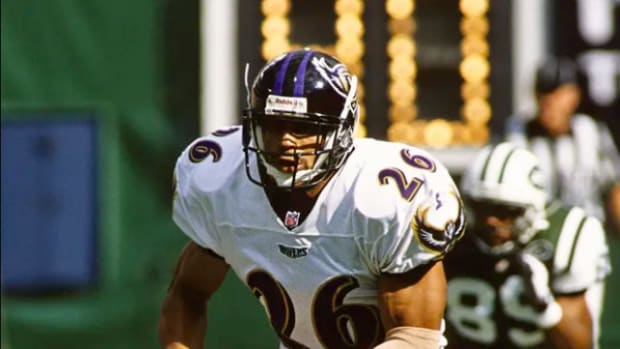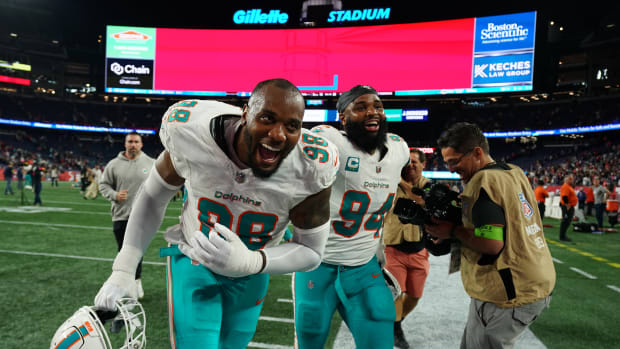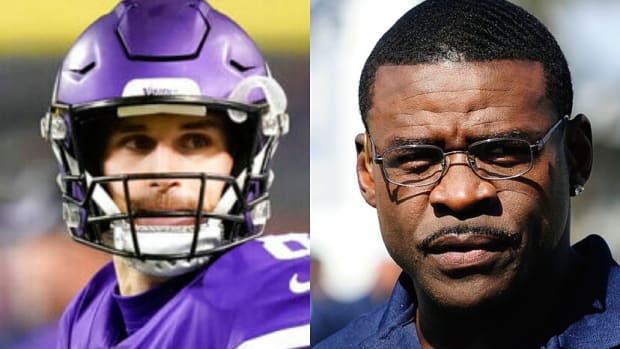You Can Thank Alex Smith for the Early Development of Patrick Mahomes
The following is excerpted from the book: QUARTERBACK: Inside the Most Important Position in the National Football League by John Feinstein Copyright © 2018 by John Feinstein Published by Doubleday, an imprint of The Knopf Doubleday Group, a division of Penguin Random House LLC.
On the night the Kansas City Chief drafted Patrick Mahomes in April of 2017, Alex Smith knew his days in Kansas City were numbered. "You don't trade up that high [the 10th pick] to take a quarterback with the idea that he's going to sit for two years," he said. "I knew my life wasn't going to change right away but it was going to change." Even knowing Mahomes was eventually going to take his job, Smith spent the 2017 season mentoring him—on and off the football field. "What he did for Patrick can't be paid back in money," Andy Reid said. "But I wouldn't have expected anything different from Alex. That's who he is."
Smith had been in Kansas City for four seasons. The Chiefs had reached the playoffs on three of those occasions but had not made it to a conference championship game. Smith was about to turn thirty-three and had two years left on his contract.
“There’s a window for players,” he said. “Just like there’s a window for teams. I felt as if I was playing as well as I had ever played, but I also know football’s a business and that coaches and general managers have to try to be one step ahead when it comes to personnel. If they’re not, they become former coaches and general managers pretty quickly.”
Which is why Smith wasn’t terribly surprised when he got a text from Andy Reid two days prior to the draft letting him know that the Chiefs were planning to use a high draft pick on a quarterback. Who it would be and exactly when it would come, he didn’t say. The point of the text was to let Smith know the Chiefs were beginning to think about Life After Alex.
BUY NOW
Quarterback: Inside the Most Important Position in the NFL
by John Feinstein
What is it like to play the most coveted position in the NFL and hold the keys to a multi-billion-dollar team? Learn what it's like to be a quarterback and face of a franchise through inside access to five of the league's starters: Alex Smith, Andrew Luck, Joe Flacco, Ryan Fitzpatrick and Doug Williams.
“The quarterback room hadn’t really changed much in terms of me being the leader for four years,” Smith said. “They hadn’t drafted anyone before the fifth round, and they had brought Nick [Foles] in specifically to be my backup. In the NFL, four years is a long time not to make any change in the QB room. It’s so important to the team that you can’t afford to get caught short.”
During Smith’s four seasons playing for Reid, there had never been any doubt that the other quarterbacks in the room were his backups, there to play only if he got hurt. Reid’s text didn’t change that. Clearly, Smith was going to be the starter in 2017. But there were no guarantees beyond that.
“What it did was make me aware that the window was starting to close,” he said. “It didn’t represent any sort of change of life for me at that moment. If they hadn’t drafted someone, my future would have still depended on whether I played well or not. If I played well, I’d have a job. If I didn’t play well, I wouldn’t have a job. The only difference really was an understanding that if I played well, I’d still have a job, but there was no guarantee that it would be in Kansas City.”
Reid wasn’t completely sure the Chiefs would get the chance to draft Patrick Mahomes, the quarterback they liked, but he felt Smith deserved a heads-up.
“I knew we liked the kid, and I knew there was a chance we were going to be able to get him,” Reid said. “I told Alex, ‘You just keep being you. Don’t look over your shoulder, because there’s no need to do that.’ I wasn’t really worried about whether he could do that or not because he’s got NFL scar tissue. I knew, if we did it, that he’d handle it well.”
As it turned out, the Chiefs decided to go all-in on drafting a quarterback they believed would be Smith’s successor. They had the twenty-seventh pick in the first round but ended up trading with the Buffalo Bills to move to the tenth spot. To do that, they had to give up their first pick, their third pick, and their number one pick in the 2018 draft.
That was a heavy price to pay to move up seventeen spots, but they had decided to push all their chips in on Mahomes, who had left Texas Tech after his junior season. Mahomes was actually a little shorter than Smith: six-two to six-four, and a little slower: 4.80 in the 40 at the combine, compared to Smith’s 4.67. He had a rifle for an arm and, perhaps most important, was eleven years younger than Smith.
“I’m realistic,” Smith said after the season had started. “You don’t spend that much to get someone with the intention of sitting them on the bench for two years. But for the moment, I’m worried only about this season. If I play well, the future will take care of itself one way or the other.”
Colin Kaepernick had talked about how supportive Smith had been after he had taken over for him as the starter in San Francisco. This was different, but Smith was very comfortable being in a mentoring role for someone he knew had been anointed as his successor.
“I’ve heard about quarterbacks, Tom Brady among them, who don’t want to share stuff with younger players,” he said. “I’m just not built that way. There’s absolutely no reason for me not to help Patrick out in any way I can. When I was young, there were older guys who went out of their way to try to teach me. There’s no reason why I can’t do that too.
“There are certain things you can tell someone player to player that’s different from coach to player. When I first got to San Francisco, I had to go from spread and shotgun to taking snaps under center. The coaches were always on me about my footwork. I was always count- ing steps, three steps, five steps, seven. It got to the point where, at times, I wasn’t even looking at the defense or at my receivers. Footwork, footwork, footwork.
“I think it’s okay to work on those fundamentals in practice. But when you get in a game, that has to all go out the window. You can’t think about that. The most important thing is your eyes. You have to see the game: know who needs to be blocked; know where the defense is; see your receivers—read the defenders. That’s all with your eyes. That’s the kind of thing I tried to work with Patrick on.”
No one was more aware of Smith’s mentoring of Mahomes than Reid. “What he did for him you can’t pay back with money,” he said.
“He helped him with things in ways that a coach simply can’t do. There was complete trust from pupil to mentor. Knowing Alex, I wouldn’t have expected anything different.”
It helped that Smith and Mahomes hit it off from the beginning. All three quarterbacks—Tyler Bray was in his fourth season as the Chiefs’ number three quarterback—got along well. Smith and his wife, Elizabeth, often had Mahomes and his girlfriend and Bray and his wife over to their house for dinner during the week.
“It was a very comfortable dynamic in the room,” Smith said. “You can never underestimate how important that is because the three quarterbacks and the quarterback coach [in this case, offensive coordinator Matt Nagy] spend a lot of time together. If you aren’t comfortable with one another, that can be a problem.”






































